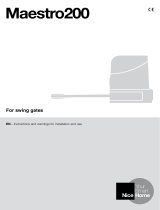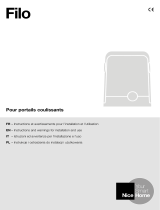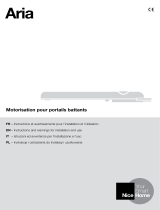Page is loading ...

FR - Instructions et avertissements pour l’installation et l’utilisation
EN - Instructions and warnings for installation and use
IT - Istruzioni ed avvertenze per l’installazione e l’uso
PL - Instrukcje i ostrzeżenia do instalacji i użytkowania
Clavier à code radio
DS100
PUK CODE

English – 1
EN
• Before proceeding with the installation, make sure the product is suit-
able for its intended use. Pay special attention to the data provided in the
“Technical Characteristics” chapter. Nice disclaims liability for any dam-
age resulting from uses of the product other than those described in this
manual.
• Protect the product’s internal components from contact with water and
other polluting substances. Keep it away from heat sources and do not
expose it to open flames. If any of these conditions occur, stop using it
immediately and call Nice customer service.
• Disconnect the power supply before proceeding with the installation opera-
tions.
• The packaging materials must be disposed of in compliance with the regu-
lations locally in force.
•
Specific warnings regarding the intended application of this product in relation to
the “R&TTE “1999/5/CE directive.
- This product complies with the essential requisites specified by section 3
of the “R&TTE” Directive regarding the use for which the product is des-
tined for in this instructions manual; the use of this product for purposes
other than those for which it was intended is prohibited.
- The usable radio frequency range is subject to national legislation; the
countries in which this product can be used are; all countries within the
European Community and Switzerland.
- Those responsible for installation should verify if the use of the products
frequency is permitted, if the country in which the product is to be used
is not mentioned in the point above.
Instructions translated from Italian
1
WARNINGS

2 – English
EN
Ideally a test should be made to ascertain the functioning and effective range
before actually fixing the DS100.
CAUTION: The place in which the DS100 is to be fixed should also be
carefully considered.
In addition to the distance from the receiver, avoid positioning it close
to, or even worse, on metal structures that could create a shield.
Place the DS100 digital selector on the wall to which it is to be fixed
and perform a transmission to ensure that the receiver receives the
The DS100 digital selector (fig. 1) is a radio
transmitter that, after having typed in the correct
secret combination, permits the remote control of
corresponding radio receivers or gate or tubular
motor control units and can only be used for Nice
Home automation systems.
The combination is typed in by means of the 10
buttons (A-fig.1) (from 0 to 9), while the 3 buttons
(B-fig.1) are used to send the 3 types of com-
mands to a similar automation or to control up to
3 different automations or receivers.
Another button (C-fig.1) is used when there is
little light, which lights the buttons so that the combination can be easily
introduced.
A series of rapid Beeps confirms that the command has been sent during
transmission.
A
B
C
1
2
PRODUCT DESCRIPTION AND APPLICATIONS
3
INSTALLATION

English – 3
EN
01.
03.
02.
04.
2
1
2
command that has been sent.
Also take into consideration that when the batteries are flat the range
can be reduced by 25÷30 %.
Once the functioning has been assured, fix the DS100 at a suitable height
as follows (fig. 2):
01. Unscrew the retaining screw
02. Remove the base of the digital selector and screw it to the wall
03. Connect the digital selector to the support fixed to the wall, hooking it to
the upper part of the support
04. Fix the selector to the support with the retaining screw

4 – English
EN
If another remote control has already been memorised on a control unit,
radio receiver or tubular motor, the DS100 digital selector can be memorised
as described below. Whereas, if a transmitter has still to be memorised, the
instructions related to the product to be commanded must be consulted to
perform the “memorisation of the first transmitter”; consult the site www.
niceforyou.com if the original instructions of the product are not available.
The memorisation procedure may change depending on the product, there-
fore the original instructions should be referred to.
Avec cette procédure, un NOUVEL émetteur est mémorisé, en utilisant un
second émetteur (ANCIEN) déjà mémorisé et fonctionnant, sans utiliser les
touches de la logique de commande mais seulement en se plaçant près de
cette dernière.
Pendant la procédure, le NOUVEL émetteur est mémorisé comme était
mémorisé l’émetteur ANCIEN (Mode 1 ou Mode 2).
Perform the following steps with the digital OLD transmitter and selector
DS100 placed close to the control unit, receiver radio or tubular motor:
Remote memorisation Example
01. Type in the secret combination (factory setting:
“11”) on the DS100 digital selector, then push a
transmission button for at least 5” and then re-
lease
1 1
B
5s
02. Slowly push the button on the OLD transmitter
3 times
X3
03. Type in the secret combination on the DS100 digi-
tal selector, then slowly push a transmission but-
ton once (the same that was used in step 01), then
release it
1 1
B
4
DS100 REMOTE MEMORISATION

English – 5
EN
At this point the DS100 digital selector is recognised by the control unit,
receiver radio or tubular motor and will take on the same characteristics as
the OLD transmitter.
The DS100 digital selector emits a tone each time a button is pushed con-
firming that it has been performed correctly.
The DS100 cannot send a radio command until the command transmission
has been enabled through the introduction of the secret combination, after
which the A B C buttons can be pushed to send the command as if the
DS100 was a normal radio transmitter.
The factory set combination of “11” can be changed at any time as described
in the “Change of combination” chapter 6.
The secret combination is composed from a minimum of 1 number to a maxi-
mum of 10 numbers (for example: 5 or 5566778899).
If no buttons are pushed within 10 seconds the combination will have to be
introduced once again in order to send another command.
If the combination is incorrectly introduced, three rapid notes are emitted
(beep-beep-beep) when the transmission is attempted that indicate that the
combination has been incorrectly typed in.
To make the introduction of the combination easier, the buttons can be lit up
at any time by pushing button C in fig. 1.
5
USAGE

6 – English
EN
The secret combination can be changed at any time as long as the present
combination is known.
To replace the combination, proceed as described below.
Change of combination Example
01.
Push button
C of fig. 1
02. Type in the present combination
1 1
03.
Push button C of fig. 1
04. Type in the new combination (max 10 numbers)
1
2 3
05.
Push button C of fig. 1
06. Type in the new combination again (max 10
numbers)
1
2 3
07.
Push button
C of fig. 1
6
CHANGE OFCOMBINATION

English – 7
EN
08. Three beeps are emitted if the operation has been
successful otherwise 5 rapid beeps are given
indicating that one of the steps was unsuccessful
Note: If one wishes to use DS100 without having to introduce a combination, a combination
with no numbers can be introduced by not pushing the buttons at points 04 and 06 of table 2.
If the combination is forgotten it can be changed by repeating the above
mentioned points and entering at point 02 of the procedure the special
default “PUK code” in place of the current combination.
Each DS100 has its own individual 10 digit “PUK” code which can be found
on the front cover of this manual.

8 – English
EN
1
2
2
1
01.
3
05.
02. 03. 04.
06. 07.
When the digital selector range is significantly reduced and/or 10 rapid
beeps are emitted when switched on, this means that the batteries are flat
and require replacement. The digital selector contains two CR2430 lithium
batteries.
If the DS100 is used in freezing temperatures (below -10°C) flat battery
signals may be given even if the batteries are still partially charged.
To replace the battery, proceed as shown in fig. 3.
7
REPLACEMENT OF THE BATTERIES

English – 9
EN
The system does not require special maintenance.
This product is made of various materials; some may be recycled and others
must be disposed of. Obtain information on product recycling or disposal, in
observance of current local standards.
Caution: come electronic components may contain pollutant
substances; never dispose of into the environment.
8
MAINTENANCE AND DISPOSAL

10 – English
EN
DS100 is produced by NICE S.p.A. (TV) Italy. Nice S.p.A., in order to improve
its products, reserves the right to modify their technical characteristics at
any time without prior notice. In any case, the manufacturer guarantees their
functionality and fitness for the intended purposes.
Note: all the technical characteristics refer to a temperature of 20°C.
Type Digital radio selector with digital combina-
tion for the control of awnings, rolling shut-
ters, gates and door automations
Adopted technology
AM OOK coded modulation of radio carrier
Frequency 433.92 MHz
Code Rolling code with 64 Bit code (18 billion
million combinations)
Irradiated power approx. 0.1mW
Power supply 6V +20% -40% with two CR2430 type
lithium batteries
Battery life 2 years, estimated on the basis of 10 com-
mands/day, each lasting 1” at 20°C (at low
temperatures the efficiency of the batteries
decreases)
No. of combinations 9.999.999.999
Operating temperature -20°C … 55°C
Protection class IP44 (for external use)
Dimensions / weigh L 65 x H 95 x D 33 / 260 g
9
TECHNICAL CHARACTERISTICS

English – 11
EN
CE Declaration of conformity
Declaration in accordance with Directive 1999/5/EC
Note: The contents of this declaration correspond to declarations in the official document deposited
at the registered offices of Nice S.p.a. and in particular to the last revision available before printing this
manual. The text herein has been re-edited for editorial purposes.
A copy of the original declaration can be requested from Nice S.p.a. (TV) Italy.
Declaration number: 586/DS100 Revision: 0 Language: EN
The undersigned, Roberto Griffa, in the role of Chief Executive Officer, declares
under his sole responsibility, that the product:
Manufacturer’s Name: NICE S.p.A.
Address: Via Pezza Alta 13, 31046 Rustignè di Oderzo (TV) Italy
Model: DS100 13-key keypad with programmable code
Accessories:
Conforms to the essential requirements stated in article 3 of the following EC direc-
tive, for the intended use of products:
• DIRECTIVE 1999/5/EC OF THE EUROPEAN PARLIAMENT AND OF THE
COUNCIL of 9 March 1999 on radio equipment and telecommunications termi-
nal equipment and the mutual recognition of their conformity, in accordance with
the following harmonised standards:
- Health and safety (Art. 3(1)(a)): EN 62479:2010
- Electrical safety (Art. 3(1)(a)): EN 60950-1:2006+A11:2009+A12:2011+A1:20
10+A2:2013
- Electromagnetic compatibility (Art. 3(1)(b)): EN 301 489-1 V1.9.2:2011,
EN 301 489-3 V1.6.1:2013
- Radio spectrum (Art. 3(2)): EN 300 220-2 V2.4.1:2012
In accordance with the directive 1999/5/EC (appendix V), the product is class 1 and
marked: CE 0682
Oderzo, 28 July 2016 Ing. Roberto Griffa
(Chief Executive Officer)
/













